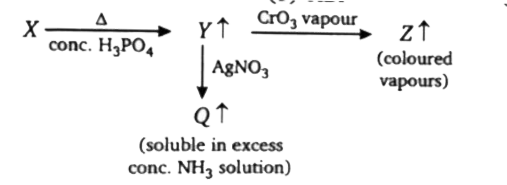In which of the following reaction, regioselectivity cannot be observed ?
The correct Answer is:3
To determine in which of the following reactions regioselectivity cannot be observed, we need to analyze the given options based on the concept of regioselectivity. Regioselectivity refers to the preference of a chemical reaction to yield one structural isomer over others when there are multiple possible products.
1. Understand Regioselectivity: Regioselectivity occurs when a reaction can lead to different products based on where a bond is formed or broken. If there is only one possible product, regioselectivity cannot be observed.
2. Analyze Each Option:
- Option A: The structure is CH3-CH(CH3)-CH2-Cl. When treated with alcoholic KOH, dehydrohalogenation occurs. The alpha hydrogen can only be removed from one position, leading to the formation of a single product (an alkene). Therefore, regioselectivity cannot be observed here.
- Option B: The structure is CH3-C(CH3)(CH3)-Cl. Here, the alpha hydrogen can be removed from multiple positions, but all lead to the same product due to symmetry. Thus, while there are multiple positions to remove hydrogen from, they yield the same product, indicating no regioselectivity.
- Option C: The structure is CH3-CH(CH3)-CH2-CH2-Cl. In this case, there are multiple alpha hydrogens available for removal, leading to different products. Thus, regioselectivity can be observed here.
- Option D: The structure is CH3-CH2-C(Cl)(CH3). The alpha carbon does not have any hydrogen atoms available to remove, hence no reaction occurs. Therefore, there is no regioselectivity here.
3. Conclusion: Based on the analysis, both Option A and Option B show no regioselectivity due to the formation of a single product. However, since the question asks for the option where regioselectivity cannot be observed, the most straightforward case is Option A, where only one product is formed.
Final Answer:
Option A is the reaction in which regioselectivity cannot be observed.
- Option A: The structure is CH3-CH(CH3)-CH2-Cl. When treated with alcoholic KOH, dehydrohalogenation occurs. The alpha hydrogen can only be removed from one position, leading to the formation of a single product (an alkene). Therefore, regioselectivity cannot be observed here.
- Option B: The structure is CH3-C(CH3)(CH3)-Cl. Here, the alpha hydrogen can be removed from multiple positions, but all lead to the same product due to symmetry. Thus, while there are multiple positions to remove hydrogen from, they yield the same product, indicating no regioselectivity.
- Option C: The structure is CH3-CH(CH3)-CH2-CH2-Cl. In this case, there are multiple alpha hydrogens available for removal, leading to different products. Thus, regioselectivity can be observed here.
- Option D: The structure is CH3-CH2-C(Cl)(CH3). The alpha carbon does not have any hydrogen atoms available to remove, hence no reaction occurs. Therefore, there is no regioselectivity here.
Option A is the reaction in which regioselectivity cannot be observed.
Topper's Solved these Questions
- ALKYL HALIDE, ALCOHOL, PHENOL, ETHERBOOK - RESONANCE ENGLISHCHAPTER - ALKYL HALIDE, ALCOHOL, PHENOL, ETHEREXERCISE - INORGANIC CHEMISTRY(Metallurgy)
17 Videos
- ALDEHYDES, KETONES, CARBOXYLIC ACIDBOOK - RESONANCE ENGLISHCHAPTER - ALDEHYDES, KETONES, CARBOXYLIC ACIDEXERCISE - ORGANIC CHEMISTRY(Aldehydes , Ketones, Carboxylic acid)
40 Videos
- AROMATIC COMPOUNDSBOOK - RESONANCE ENGLISHCHAPTER - AROMATIC COMPOUNDSEXERCISE - Part - III Practice Test-22
1 Videos
Similar Questions
Knowledge Check
In which of the following reactions, regioselectivity can be observed?
A B
B C
C D
D
Which of the following reactions are both stereospecific and regioselective ?
View SolutionWhich of the following cannot he formed ?
View SolutionWhich of the following cannot be polarised?
View SolutionWhich of the following cannot fix nitrogen?
View SolutionWhich of the following cannot be hydrolysed?
View Solution
Which of the following anion cannot be in X?
View Solution
Which of the following anion cannot be in X?
View Solution
